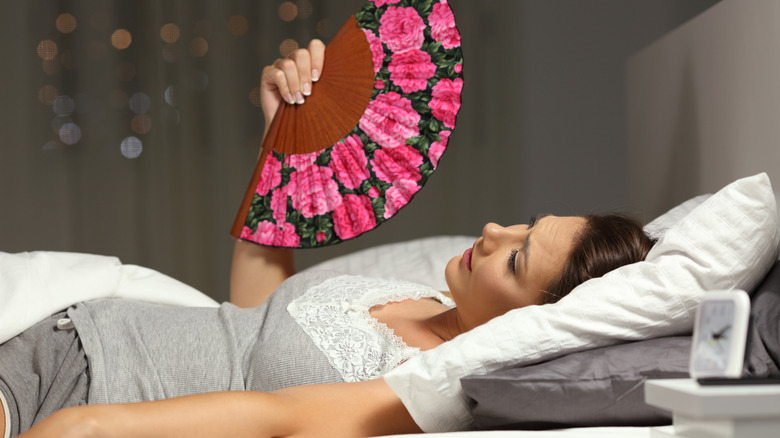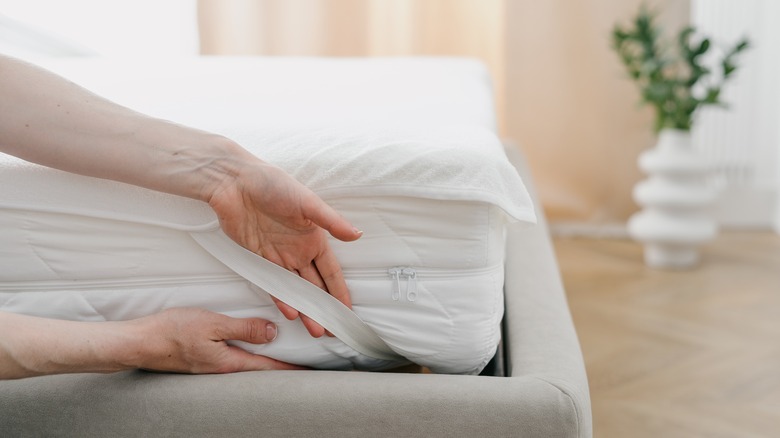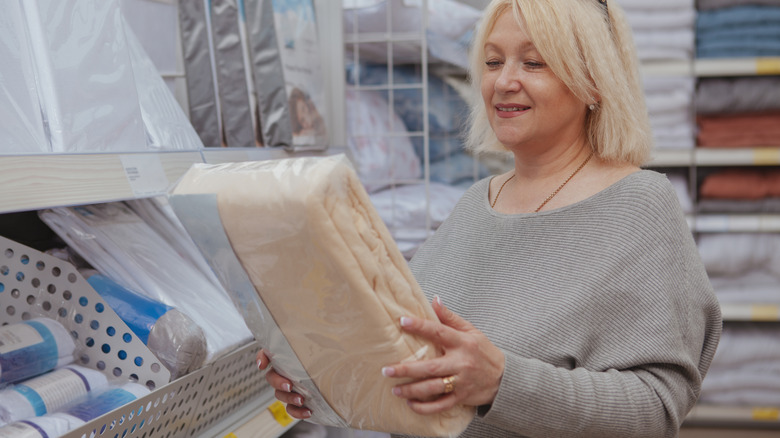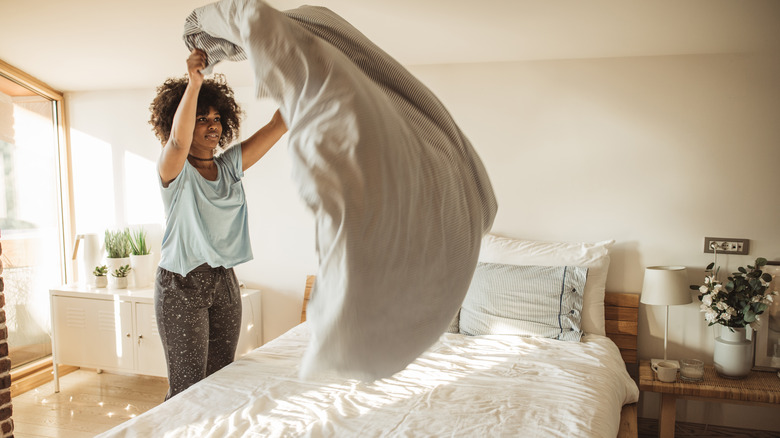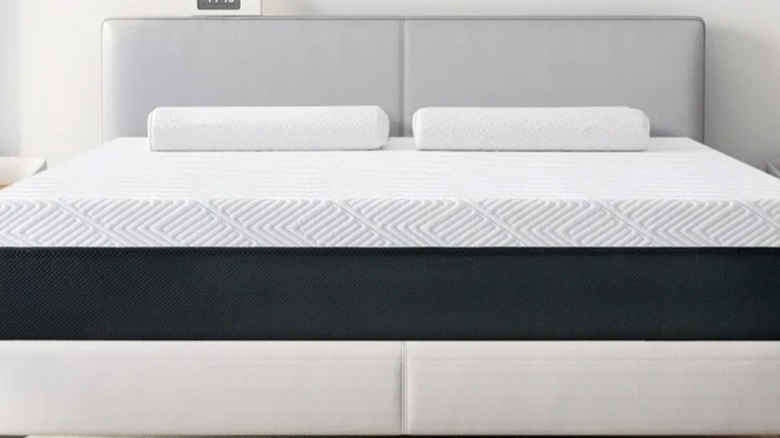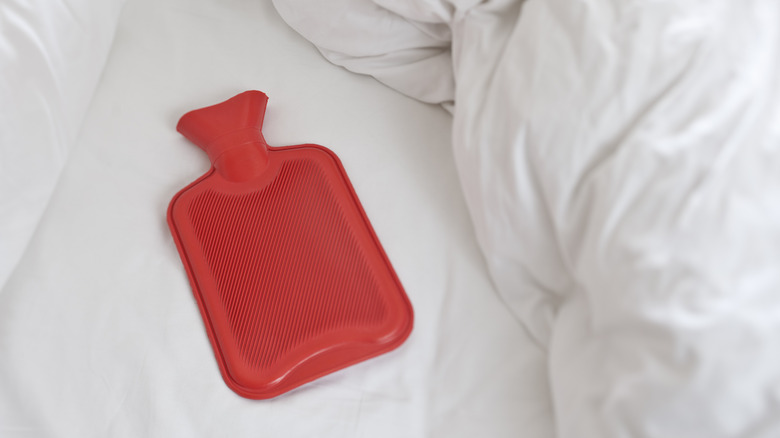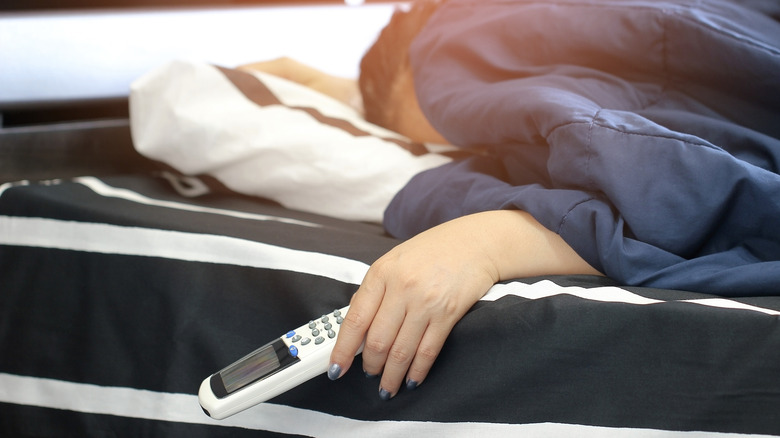9 Tips To Help Keep Your Mattress Cool During Toasty Summer Nights
You freshen up, turn off the lights, set your phone on silent, snuggle in the covers, and prepare to count sheep before drifting off. Yet, your well-laid plans will go awry if you wake up in the middle of the night, sweating profusely. There could be multiple reasons for this, including how much heat your mattress retains.
If your bed doesn't have breathable air channels, it will trap heat inside, especially during the hot summer months. While you can always switch on the AC to sleep comfortably, your sky-high utility bills will throw your carefully crafted budget into disarray. Don't worry, though. There are several ways to cool down your mattress and enjoy a good night's sleep, like getting a cooling mattress topper.
Before we delve into how to cool your bed, ensure your mattress is the culprit, not your lifestyle choices. For instance, if you like to wear warm, cozy pajamas to bed, switch out your cozy nightwear with summer-appropriate fabrics like cotton and linen to avoid perspiring through the night. Similarly, tie back your long hair to keep your neck sweat-free, and avoid wearing tight clothes to bed, as they'll trap heat inside. Moreover, minimize the usage of electronics in your bedroom since they give off heat. Further, try blackout curtains to block sunlight and maintain a chill atmosphere. However, if none of these tricks work, here are a few tips to help keep your mattress cool during toasty summer nights.
Get a cooling mattress topper
One of the best ways to cool your mattress is to lay a cooling mattress topper on it. Generally, these toppers are 2 to 4 inches thick (some might go up to 8) and provide an extra layer of cushioning. Although they sound similar to traditional mattress toppers, cooling ones are specifically designed to remain cool during hot weather. They achieve this by promoting air circulation and drawing heat away from your body. The best part, though? They aren't a permanent addition to your bed and can be easily added or removed, depending on the weather and your cooling needs.
To sleep comfortably through the night, you need to pick the right cooling topper. Begin by considering the material of the topper. Latex cooling toppers feature an open-cell composition that makes airflow easier, dissipating heat from your body. However, this natural material is more expensive than its competitors. Gel-, copper-, graphite-, or charcoal-infused memory foam is another good option. Alternatively, polyfoam is an affordable option but tends to get dinged and indented more easily than others.
If you experience hot climates year-round, go for mattress toppers with phase-change materials engineered to remain chill. Next, consider the topper's thickness so you're comfortable at night. For instance, side sleepers benefit from moldable, thick toppers, while thin, firm toppers work best for stomach sleepers. Additionally, get a washable cover for your topper since they aren't machine-friendly and will require this protection to remain sanitary.
Invest in cooling pillows
A cooling mattress topper won't be of much help if you wake up with your hair matted in sweat. This is where a cooling pillow comes in. Besides offering ample support for your spinal cord, these pillows are designed to decrease the temperature around your neck, head, and shoulders and keep them cool so you can sleep undisturbed. They may be made from breathable fabrics, a gel- or water-based outer layer, or phase-change materials. Each of these designs helps to improve the airflow or draw away moisture and heat. To get your money's worth, focus on the pillow's cooling technology or material.
Look for memory foam pillows with a shredded core (if you want them to be flexible) or gel-, copper-, graphite-, and volcanic sand-infusion, as they move heat away from your body. Latex and phase-change are especially suitable for individuals who run hot, whereas polyester treated with cooling technology is a good alternative for people with an allergy to latex.
Additionally, consider your sleeping position to choose the right loft (height) and firmness for you. For example, if you sleep on your stomach, get a relatively soft and slim pillow. Alternatively, a firm and high pillow is best if you sleep on your side. Back sleepers should get a pillow that keeps their head and neck level. Ensure you follow the manufacturer's laundering instructions to properly wash your bed pillows or keep a cooling cover over them if they are not washable.
Choose the right bed sheets
You might get the best cooling mattress topper and pillow, but your efforts will be for naught if the sheet fitted onto your bed isn't conducive to the hot climate. It's important to be aware of the best types of bedsheets for every season to choose the right ones for summer. Ideally, the sheets should promote air circulation, shouldn't make you sweat, and should absorb or siphon away perspiration from your body. To sleep comfortably during hot and sweaty nights, look for three things: the sheet's material, weave, and thread count.
Cotton is one of the best bedsheet materials because it's incredibly breathable. Go for Egyptian and Pima long-staple cotton sheets or the combed variety for a luxurious touch. Made from flax, linen is the next best material. These sheets feel coarse initially, are more expensive, and wrinkle easily. Viscose is another plant-based material. It's processed from wood pulp (mostly bamboo) and is soft and smooth to the touch. Lyocell is viscose's cousin, derived from the wood pulp of beech, birch, eucalyptus, and spruce. Natural silver sheets are also a good option for summer.
Regarding weave, percale cotton is superior to sateen and twill, as it's more breathable than its contemporaries and lends the bed sheets a refreshing touch. Look for bed sheets within the 200 to 400 thread count, since a higher count will limit airflow.
Maintain a cool atmosphere in your bedroom
Your bedroom's temperature directly impacts your circadian rhythm. This means if your bedroom is too hot, you'll wake up sweaty, feel dehydrated, and your sleep quality will suffer. So, it's vital to maintain an optimal temperature inside your room. Sleep psychologist Michelle Drerup says 60 to 67 degrees Fahrenheit is the ideal temperature to keep your bedroom at (via Cleveland Clinic).
Start by changing your fan's blade movement from clockwise to counter-clockwise to enjoy a cooling breeze. Moreover, stop charging your electronic devices at night since they give off heat and turn your room hot. Following a similar logic, avoid using your phone, laptop, or other gadgets in bed. Make it a habit to charge your devices after you wake up. In a similar vein, don't switch on all the lights in your bedroom since they can emit heat, too. When you need a bit of light in your bedroom, replace your traditional light bulbs with LEDs, as they give off less heat and consume less energy. Win-Win!
Further, run a dehumidifier in your room if you experience a humid climate and wake up hot and sticky. Although this won't cool your room, it will counteract the excess moisture in the air, making breathing easier in the oppressive atmosphere. Further, keeping the windows shut during the day will keep the glaring sunlight out. Contrastingly, open them at night to move the stale, hot air out and allow fresh air in.
Check your duvet's tog rating
Ideally, you'd replace your snug winter blankets with thin cotton sheets come summer. However, if you find the weight of duvets comforting and would rather continue to use them when temperatures soar, get a summer duvet. Designed specifically for the warmer months, these comforters won't overheat your body. On the contrary, they'll draw away moisture while keeping you comfy all night long. But, before you purchase a duvet for the summer, check its tog rating to ensure you get the right one.
Ranging between 1 and 15, a duvet's tog rating informs you how warm it is and whether it will trap heat. The lower the rating for a comforter, the cooler it will be, and vice versa. For instance, a duvet with a tog rating of 2.5 to 4.5 is best for summers, while 10.5 to 13.5 is ideal to beat a winter chill. Choose a comforter based on your body's temperature, the weather, and how cool your bedroom gets at night. If this feels like too much of a hassle, get an all-season duvet. They usually come with two detachable parts (with distinct tog ratings) that you can add or separate based on your needs.
Don't forget to pay attention to the fill material. If possible, go with natural fillers, like down and feather duvets, wool, bamboo, eucalyptus silk, since they allow air to pass through, are lighter than synthetic comforters, and can regulate temperature. Moreover, they're soft, long-lasting, and eco-friendly.
Select a mattress fit for summers
If your bed frame is outfitted with a traditional memory foam mattress and budget isn't an issue, get a new mattress. This is because memory foam mattresses tend to capture and absorb heat, making them supremely uncomfortable during summer months. To avoid lying in your pool of sweat, replace your old mattress with a new one that's fit for summer. However, before you rush to the store (or order one online), check if you have a spring or pocket spring mattress, as they typically have two sides: one for winters, the other for summers. In case you have a dual-sided mattress, flip it over instead of buying a new one, provided it's in relatively good condition.
To choose the best mattress, pay attention to the material's air circulation capacity and construction. You want to buy a mattress made of breathable fabrics such as cotton and bamboo. These materials will promote airflow without retaining heat. Hyper-elastic polymers are a good option, too.
Regarding the type of mattress construction, coil-weaved innerspring, natural latex, open-cell memory foam, and coil and foam hybrid mattresses are all great selections. Test a few mattresses to determine what you like. Additionally, determine the bed's firmness, as discomfort can wake you in the night and add to your sleeping troubles. Similarly, a too-hard surface will limit your body's blood flow. Bring home a mattress that's comfortable and falls between these extremes to sleep soundly.
... Or go for a cooling mattress
If you experience night sweats, live in a tropical climate year-round, or run hot, consider buying a cooling mattress. Cooling mattresses are engineered using materials and technologies to minimize heat retention at the surface so you stay cool through the night and remain asleep. That's not all. Since these mattresses employ thermoregulation, you won't have to run the AC all night long to keep night sweats at bay, allowing you to cut back on your summer-induced electricity bills. Plus, the lack of perspiration will increase the lifespan of your mattress, giving you a higher ROI (return on investment).
That being said, not all mattresses marketed as cooling provide the desired results. So, check the material and technology being used. A mattress made of phase change chemicals is an efficient cooler: Phase change materials may be used to soak in heat but then re-release heat while transitioning from one state to another. This actively cools the mattress. As they can hoard five to 14 times more warmth than a regular mattress, they let you sleep uninterrupted.
Similarly, memory foam can be suffused with cooling gels to help it siphon off heat from your body in real time. However, if your room resembles an oven at night, you might purchase a smart mattress to actively control your bed's temperature and sleep comfortably. Remember, the built-in sensors and motors come at a premium. This means these beds tend to be costlier than their traditional cooling counterparts.
Break out your hot water bottle
In case you're craving immediate relief from the heat, get your hot water bottle out. Typically, you'd fill these with hot water, seal its mouth with a stopper, and apply it on your sore muscles for relaxation. Given that these bottles are excellent insulators and conductors, they can be used to create a makeshift ice pack to provide relief on sweltering nights. This trick isn't time- or effort-intensive and will hardly cost you anything since all you need is tap water and a hot water bottle.
All you have to do is fill the water bottle with tap water and pop it in the freezer. Leave the bottle in the fridge for five to six hours or as long as it takes for the water to solidify. Once it's frozen and you're ready to go to bed, take out the bottle and place it between your sheets to cool them down and enjoy a chill bed.
Remember, this will offer temporary relief, as the ice pack will melt after a while, and the icy water will eventually assume room temperature. If you sweat more around the neck and shoulders, leave the bottle on your pillow for a few minutes before you doze off. Alternatively, dampen a clean towel, put it in the freezer for a few hours, and wrap it around your neck or wrist to bring down your internal temperature.
Purchase an active bed cooling system
If you aren't a big fan of passive cooling products like mattress toppers, sheets, and pillows and don't want to invest in a smart bed yet, an active cooling mattress or topper might offer adequate relief. Usually, these devices use a pump or fan to circulate cold water or air through your bed to keep it cool. Unlike passive products, they don't just move heat away from your vicinity. They 'actively' work to lower your bed's temperature and help you get a good night's sleep.
On the flip side, they aren't as simple as laying down a topper on your bed or replacing your pillows. You'll have to spend time setting up these devices. Moreover, they require energy and space near your bed. Some devices might also produce whirring sounds, which might disturb sensitive sleepers.
If you're okay with the caveats, here are some things you should consider while purchasing an active bed cooling system. For starters, check if you can control the temperature and fan speed. See if the device can regulate the temperature during the night based on your sleep cycle. For instance, can the system warm you up when it's time to wake up? Determine if you can control the system via an app on your smartphone or whether it comes with a remote. Finally, see if the device has built-in dual zones so your sleeping partner can effectively dictate the temperature of their bedside.
